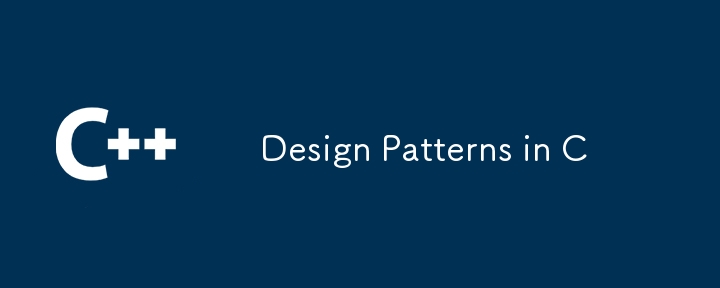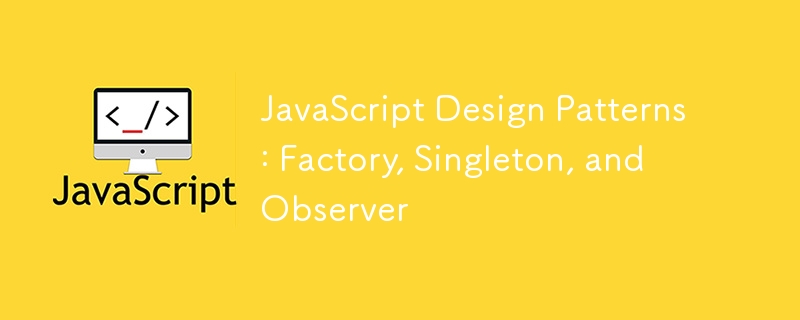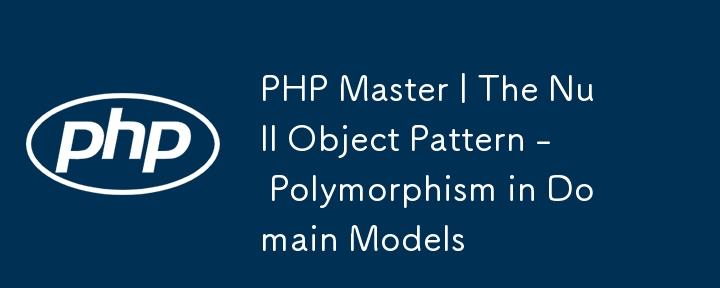Found a total of 10000 related content

Design Patterns in C
Article Introduction:The most commonly used design patterns in C include singleton mode, factory mode, observer mode, and policy mode. Singleton mode ensures that a class has only one instance and provides global access points, which is often used in scenarios such as configuration managers; factory mode encapsulates the object creation process so that the caller does not need to know the specific class name, which is suitable for situations where the object creation logic is complex or changeable; observer mode implements a one-to-many dependency notification mechanism, which is widely used in UI updates or event listening systems; policy mode allows runtime switching algorithms or behaviors, and is suitable for scenarios such as payment systems that require dynamic changes in processing methods. These modes help developers build clearer and easier to maintain code structures by decoupling, hiding implementation details, and improving scalability.
2025-07-25
comment 0
329

Understanding the Laravel Service Container and Binding?
Article Introduction:Service containers are the core tool for Laravel to manage dependencies and perform dependency injection. They reduce coupling by automatically parsing dependencies and improve code testability and flexibility. 1. It is like a "factory", which automatically creates objects and manages its life cycle; 2. Binding is used to tell the container how to create class instances. Common methods include bind() (new every time), singleton() (singleton) and instance() (existing instances); 3. Common usage scenarios include interface and implementation binding, singleton binding shared resources, and conditional binding switching implementation; 4. It is not recommended to over-binding to keep the code concise and clear. Mastering service containers helps write more flexible and maintainable Laravel applications.
2025-07-23
comment 0
226

How to implement a thread-safe singleton pattern in Java?
Article Introduction:There are three main ways to implement thread-safe singleton mode: First, use double check lock and volatile keywords, enter the synchronization block after the first check that the instance is empty, and confirm again whether it is empty, ensuring that only one instance is created; second, use static inner class (BillPugh implementation) to ensure thread safety during class loading through JVM, delay loading and no explicit synchronization is required; third, use enumeration to implement singleton, which is naturally thread-safe and can prevent reflection and serialization attacks, but may not be suitable for complex initialization or inheritance. In addition, the simple lazy style affects performance because each call needs to be synchronized, and is not recommended to use in a multi-threaded environment. Choose different implementation methods according to your needs to take into account security, performance and simplicity
2025-07-13
comment 0
500

Understanding Autoloading in PHP: How to Implement and Use It Efficiently
Article Introduction:Autoloading in PHP: Concept and Implementation
Autoloading is a mechanism in PHP that automatically loads classes when they are needed, without requiring an explicit include or require statement for each class file. It helps streamline code org
2025-01-01
comment 0
710

Mastering C# .NET Design Patterns: From Singleton to Dependency Injection
Article Introduction:Design patterns in C#.NET include Singleton patterns and dependency injection. 1.Singleton mode ensures that there is only one instance of the class, which is suitable for scenarios where global access points are required, but attention should be paid to thread safety and abuse issues. 2. Dependency injection improves code flexibility and testability by injecting dependencies. It is often used for constructor injection, but it is necessary to avoid excessive use to increase complexity.
2025-05-09
comment 0
1035

Exploring Common Java Design Patterns with Examples
Article Introduction:The Java design pattern is a reusable solution to common software design problems. 1. The Singleton mode ensures that there is only one instance of a class, which is suitable for database connection pooling or configuration management; 2. The Factory mode decouples object creation, and objects such as payment methods are generated through factory classes; 3. The Observer mode automatically notifies dependent objects, suitable for event-driven systems such as weather updates; 4. The dynamic switching algorithm of Strategy mode such as sorting strategies improves code flexibility. These patterns improve code maintainability and scalability but should avoid overuse.
2025-08-17
comment 0
691

Implementing the Repository Pattern in Laravel.
Article Introduction:The purpose of implementing the Repository mode in Laravel is to decouple business logic and data access layer and improve code maintainability and scalability. 1. Create Interface and specific implementation classes; 2. Bind the interface to the implementation class through ServiceProvider; 3. Dependency injection interface in the Controller and call methods. Use the app/Repositories directory to store the UserRepositoryInterface and EloquentUserRepository examples, register the binding through the bind method, and access user data using dependency injection in the UserController. This mode is suitable for multiple data sources
2025-07-20
comment 0
815

Understanding Dependency Injection in Laravel?
Article Introduction:Dependency injection automatically handles class dependencies through service containers in Laravel without manual new objects. Its core is constructor injection and method injection, such as automatically passing in the Request instance in the controller. Laravel parses dependencies through type prompts and recursively creates the required objects. The binding interface and implementation can be used by the service provider to use the bind method, or singleton to bind a singleton. When using it, you need to ensure type prompts, avoid constructor complications, use context bindings with caution, and understand automatic parsing rules. Mastering these can improve code flexibility and maintenance.
2025-07-05
comment 0
1113

What is the Factory pattern?
Article Introduction:Factory mode is used to encapsulate object creation logic, making the code more flexible, easy to maintain, and loosely coupled. The core answer is: by centrally managing object creation logic, hiding implementation details, and supporting the creation of multiple related objects. The specific description is as follows: the factory mode handes object creation to a special factory class or method for processing, avoiding the use of newClass() directly; it is suitable for scenarios where multiple types of related objects are created, creation logic may change, and implementation details need to be hidden; for example, in the payment processor, Stripe, PayPal and other instances are created through factories; its implementation includes the object returned by the factory class based on input parameters, and all objects realize a common interface; common variants include simple factories, factory methods and abstract factories, which are suitable for different complexities.
2025-06-24
comment 0
485

What are design patterns, and how can they be used in PHP?
Article Introduction:Common applications of design patterns in PHP include Singleton, Factory, Observer, and Strategy. They are reusable templates to solve duplication problems, not code that is directly copied. Use scenarios include code duplication, project size expansion, improved testability and reduced dependency. The application steps are: first understand the problem, then select the appropriate mode, keep it simple to implement, and can be reconstructed and optimized later. For example, Factory mode can be used to return different database instances based on configuration, thereby simplifying maintenance.
2025-06-23
comment 0
781

How to implement the singleton pattern in Python?
Article Introduction:There are three main ways to implement Singleton mode in Python: 1. Use a decorator to control the creation and reuse of class instances by defining closure functions. The advantages are that the code is clear and reusable, but the debugging is not intuitive enough; 2. Rewrite the \_\_new\_\_ method to maintain the instances within the class. The advantages are more native and object-oriented, but pay attention to multi-threaded safety issues; 3. Use the natural singleton characteristics of the module to directly create instances in the module and export and use them, which is simple and easy to maintain but poor flexibility. Choose the appropriate method according to actual needs: flexibly control the selection of decorators, object-oriented selection of \_\_new\_\_, and use the modules simply globally.
2025-07-14
comment 0
346

Advanced Conditional Patterns for Building Flexible PHP Applications
Article Introduction:Use the policy mode to replace the conditional logic with interchangeable behavior; 2. Use the empty object mode to eliminate null value checks; 3. Use the state mode to let the object change behavior according to the internal state; 4. Combining complex business rules through the specification mode; 5. Combining command mode and guards to achieve unconditional execution control; 6. Use class-based distribution to replace switch statements; these modes improve the maintainability, testability and scalability of the code by converting the conditional logic into polymorphism and combination, thereby building a more flexible PHP application.
2025-07-31
comment 0
648

A Guide to JavaScript Design Patterns
Article Introduction:The JavaScript design pattern is a reusable solution to common software design problems, helping to write maintainable, extensible, and well-structured code. 1. The module mode is encapsulated through IIFE or ES6 modules to protect private variables and avoid global pollution; 2. The observer mode allows object subscription to the main body changes, which is suitable for event processing and state updates, and is the basis of Redux and other libraries; 3. The factory mode dynamically creates objects at runtime and centrally manages object generation logic; 4. The singleton mode ensures that there is only one instance of a class, which is often used for configuration management but needs to be used with caution to avoid testing difficulties; 5. The decorator mode dynamically adds functions without modifying the original object, and is often used in logs, caches and other scenarios; 6. Revealing the module mode by returning to private
2025-07-29
comment 0
766

JavaScript Design Patterns: A Guide to the Factory, Singleton, and Observer Patterns
Article Introduction:Factory mode encapsulates object creation logic, making the code easier to maintain and expand, and is suitable for dynamically creating different types of objects, such as UI components or service instances; 2. Singleton mode ensures that a class has only one instance and provides global access points. It is often used in shared resource scenarios such as logging and configuration management, but excessive use should be avoided to prevent testing difficulties; 3. Observer mode defines a one-to-many dependency between objects, and automatically notifies all observers when the subject state changes. It is widely used in event systems, state management and real-time update functions to promote loose coupling between components. These three design patterns solve the problems of object creation, instance control and behavioral communication respectively. The rational use can improve the readability, maintainability and scalability of the code.
2025-08-21
comment 0
510

JavaScript Design Patterns: Factory, Singleton, and Observer
Article Introduction:Factory mode is used to create objects without exposing construction logic, and generate different types of objects through a unified interface, which is suitable for creating scenarios of multiple similar types of objects; 2. Singleton mode ensures that a class has only one instance and provides global access points, which are often used in scenarios such as configuration management and loggers that require a single state; 3. Observer mode establishes a one-to-many dependency relationship, which automatically notifies all observers when the subject state changes, and is widely used in event systems and data binding. These three modes solve the problems of object creation, instance uniqueness and state response, and use them in combination can improve the modularity, maintainability and scalability of the code.
2025-07-29
comment 0
293

How does dependency injection improve code testability and maintainability in PHP?
Article Introduction:Dependency injection (DI) makes PHP code easier to test and maintain by reducing tight coupling between components. Its core advantages include: 1. Simplify unit testing, allowing injection of simulated objects to replace real services, avoid side effects, and improve testing speed and reliability; 2. Promote loose coupling, making the class dependency interface rather than concrete implementation, making it easier to independently modify and expand components; 3. Improve reusability and configuration flexibility. The same class can achieve diversified behavior by injecting different dependencies in different contexts, such as the development, production and testing environments using different logging methods. In addition, modern PHP frameworks such as Symfony and Laravel built-in DI containers further simplify the implementation of object management and dependency injection.
2025-06-04
comment 0
585

Proxy Pattern in Python
Article Introduction:The proxy mode is accessed through the intermediary control object and is suitable for delayed loading, permission control, remote call and other scenarios. 1. Delayed loading: The agent creates real objects only when the first call is called, saving resources; 2. Permission control: The agent checks the user role and decides whether to allow access; 3. Remote call or logging: The agent encapsulates remote services or adds logs, performance monitoring and other functions; it can also simplify the proxy class implementation through __getattr__ to reduce boilerplate code.
2025-07-17
comment 0
761

How Do You Implement Dependency Injection in PHP?
Article Introduction:Dependency injection (DI) is a way in PHP to pass dependencies to a class rather than hard-coded inside a class. 1. DI passes the dependencies of the object to the outside through constructors or settings methods to improve code flexibility and testability; 2. DI can be implemented manually, suitable for small projects; 3. Complex applications can use DI containers to automatically resolve dependencies, such as Symfony and Laravel built-in containers; 4. Common misunderstandings include premature over-design, type prompts specific implementation rather than interfaces, abuse of service locators, etc. Correct use of DI can significantly improve code quality and maintenance efficiency.
2025-07-18
comment 0
824

How to Implement Dependency Injection in PHP
Article Introduction:Implementing dependency injection (DI) in PHP can be done by manual injection or using DI containers. 1) Manual injection passes dependencies through constructors, such as the UserService class injecting Logger. 2) Use DI containers to automatically manage dependencies, such as the Container class to manage Logger and UserService. Implementing DI can improve code flexibility and testability, but you need to pay attention to traps such as overinjection and service locator anti-mode.
2025-05-07
comment 0
1174

PHP Master | The Null Object Pattern - Polymorphism in Domain Models
Article Introduction:Core points
The empty object pattern is a design pattern that uses polymorphism to reduce conditional code, making the code more concise and easy to maintain. It provides a non-functional object that can replace the real object, thus eliminating the need for null value checks.
Empty object mode can be used in conjunction with other design modes, such as factory mode creating and returning empty objects, or policy mode changing the behavior of an object at runtime.
The potential disadvantage of the empty object pattern is that it may lead to the creation of unnecessary objects and increase memory usage. It may also make the code more complicated because additional classes and interfaces are required.
To implement the empty object pattern, you need to create an empty object class that implements the same interface as the real object. This empty object provides a default implementation for all methods in the interface, allowing it to replace the real object. This makes
2025-02-25
comment 0
644



















